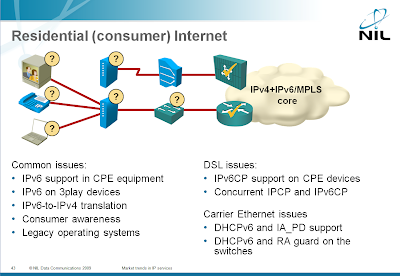IPv6 is not ready for residential deployment
The main driver for IPv6 deployment is the IPv4 address space exhaustion, caused primarily by fast growth of residential users.
Each residential user needs an IP address, a small company doesn’t need anything more and even a reasonably-sized company can survive with a few IP addresses.
One would expect the vendor readiness to follow this pattern, but the situation is just the opposite: while the enterprise networking devices have pretty good IPv6 support (Data Center components from some vendors are a notable exception), the vendors serving the residential market don’t care.
The Service Provider-related IPv6 challenges are covered in my Market trends in Service Provider networks workshop. You can attend a web-based tutorial version or we can organize a dedicated workshop event for your team.
It’s amazing how unprepared the residential vendors are: only a few of them offer IPv6-capable DSL CPEs or low-cost routers (make sure you read the whole thread). When faced with the lack of IPv6 feature support, some vendors even have the nerve to hint that you should use a public-domain firmware instead of their own.
The situation is no better in the 3play space: try finding a set-top box running IPv6. Oh, and all devices in the path should support wire-speed IPv6 multicast which is needed to deliver the video stream to set-top boxes.
Realistically, I’d expect most of the 3play solutions staying within the IPv4 address space for a long time; they’re commonly using private IP addresses, so they are not affected by the IPv4 public address space exhaustion.


http://www.ripe.net/ripe/meetings/ripe-54/presentations/IPv6_management.pdf
Still no customer is ready for ipv6. how to convince them.
https://www.isc.org/software/aftr